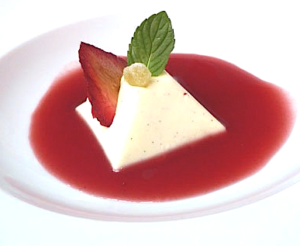After my third meal in Spain I came to realize (and cherish) the fact that Spanish food is not spicy; it is quite delicate and complex, but never overshadowed by hot peppers, spices or drowned in flavored sauces. Don’t get me wrong, I love my spices and am fond of hot peppers and seductive sauces, but it was nice to experience the true flavor of each ingredient.
In Spain, home cooks and chefs alike lovingly prepare meals using seasonal, high-quality, local, fresh ingredients. This of course is the reason why most American travelers visiting Europe (and other countries that embrace this simple yet wise philosophy), often wonder why the meals served abroad are so flavorful and special even when simply prepared. Local, in-season and high-quality ingredients are the key to exceptional cooking and eating well; something we should all embrace. Not to mention it’s also the most nutritious and healthy approach.
With that said, while in Spain seek out the best tapas bars and local favorites and try to experience at least one of the top restaurants run by highly acclaimed chefs such as Paco Torreblanca, Juan Mari Arzak, Martin Berasategui, Juan Roca, Jordi Atal, lberto Chicote, Quique Dacosta, Carme Ruscalleda, Daniel Garcaa, Santi Santamaría, and Paco Roncero to name a few. Allow yourself to indulge and experience the full range of all Spain has to offer.
Eating and drinking in Spain could be an exceptional, memorable experience if you do a bit of homework before you arrive. First, be aware that dining routines may greatly differ from your own. For example, breakfast is often simple–coffee or tea served with a croissant or pastry, or bread and cheese. The midday meal, la comida, (our lunch), is the largest meal of the day and is served from 2:00 – 4:30. Spaniards typically eat dinner very late–9PM or 10PM. There are few places that will serve dinner at 6:00, but you need to research in advance or speak to your hotel for suggestions.
Next, take some time to research the restaurants in the regions you will visit. Be open to trying new things but wise about basing choices on your culinary preferences and budget. Spanish cuisine ranges from highly innovative avant-garde creations to simply prepared traditional fare. There is something for most dining preferences and as such, you will find restaurants ranging from affordable to quite expensive. I’ve heard a few stories of complete shock when calculating the final bill. While most places welcome walk-ins be sure to make reservations for Spain’s in-demand culinary meccas.
The country has many distinct regions that provide a variety of cooking styles and famous dishes. Here is a breakdown found on Wikipedia that showcases some of Spain’s regional fare and special dishes. While a generalization, I have read a guideline to follow is that in the north they tend to stew, in the center of the country they bake and in the south they fry. However, when you experience the new modernist cuisine and/or molecular gastronomic movements in Barcelona and San Sabastian, all such rules are broken.
Catalonia: Alongside Valencia, Catalonia has a long tradition of rice-dishes and seafood. In addition, cooked and cured sausages from Vic are famous. Catalan cuisine is rich. Favorites include Catalan Bread (pa amb tomàquet) and botifarra (spanish sausage), and Catalan Cream which is similar to crème brûlée.
La Rioja: Known above all its international Rioja wines, as well as its vegetable soups and its pepper and potato dishes.
Extremadura: Local fare includes Cocido extremeño (a rich stew of bacon, fowl, ham, meats, and vegetables), embutidos of Iberian pork, cheeses (including the indispensable torta del casar, a close relative of the Portuguese queijo da serra), pitarra wine.
Andalusia: (Andalucia) Local fare includes fried fish, salmorejo and gazpacho. Seafood, especially shrimp, squid, mackerel and flatfish. Jabugo ham and Sherry wine.
Aragón: Known for Somontano, Borja and other wines. Jamón serrano (cured ham) in Teruel. Migas, very typical in small villages. Nuestra Señora del Pilar sweets in Zaragoza. “Ternasco con patatas a lo pobre”, one of the most popular dishes in Aragón. “Borrajas”, vegetable typical of this zone. Peaches with red wine (from Calanda, in Teruel). And “chiretas”, very popular in “Ribagorza” and “Somontano de Barbastro”.
Murcia: Known for products of its rich gardens, such as zarangollo; fish and lamb stews; and the wines of Jumilla, Yecla or Bullas. They are also fantastic murcia midges, a dish using leftover bread or tortas)
Valencia: The Valencian region is famous for its Paella that is made with seafood, meat and vegetables. Many other variants of rice-based dishes can be found in Valencia, with shellfish, meatballs or just covered in egg (“Arròs amb crosta”).
Balearic Islands: A typical island-based diet of seafood and simple vegetable-based dishes as well as Sobrasada (sausage). Samfaina (Ratatouille) and Cocas (pastry) are typical of Catalan cuisine generally. Majorca’s biggest export is the Ensaimada, a pastry.
Basque country: Skillfully cooked dishes such as “txangurro relleno” (spider crab) “marmitako” and hake and clams. Idiazabal cheese and a distinctive wine called “txakoli”. Piquillo peppers, filled with cod or tuna.
Navarre: Best known for its vegetable stews, Tudela’s lettuce hearts with anchovies, salmon, or a simple vinaigrette (oil, salt and vinegar); piquillo peppers, which are often stuffed with meat; trout à la Navarra (cooked stuffed with bacon and cheese), Roncal and Idiazabal cheeses, curd from Ultzama, claret wine, and patxaran liquor.
Galicia: Local fare includes Caldo gallego; an array of seafoods, especially octopus, cod and goose barnacles; Tarta de Santiago, a tart made of almonds and lemon; empanadas; Albariño wine from the Rias Baixas.
Castilla y León: Best know for its Morcilla (black pudding made with blood and different spices) from León, Burgos or Valladolid; Sopa de Ajo (Garlic soup), Cochinillo asado (little roast pig), Lechazo (Roast Lamb), Botillo del Bierzo, Hornazo (meat pie) from Salamanca, and Jamón de Guijuelo (Spanish cured ham from Guijuelo (Salamanca). Also known for a great variety of sausages like Salchichas de Zaratán and cheeses like Cheese of Serrada or Burgos’s Fresh Cheese and various of the best wines in Spain *Ribera del Duero wines.





